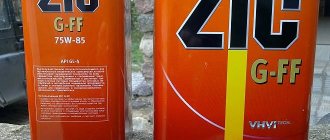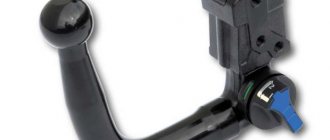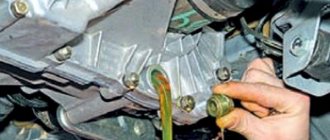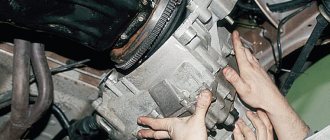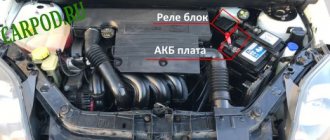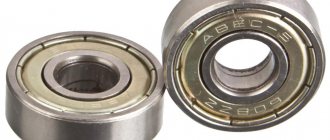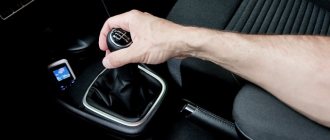As you know, the gearbox is one of the most important components of a car, responsible for transmitting torque from the engine crankshaft to the drive wheels. Modern cars are equipped with manual or automatic transmission.
At the same time, the types of vehicle transmissions can differ significantly, since in addition to manual transmission (manual transmission) and automatic transmission (classic automatic hydromechanical type), there is also a sequential manual transmission, manual transmission (automatic robotic transmission or electronically controlled manual transmission), variator (continuously variable gearbox), etc.
All types and types of gearboxes have differences in operation, design and functionality. In this article we will look at what types of manual transmissions and types of automatic transmissions there are, as well as the main features of various types of transmissions.
What does a gearbox do?
The gearbox is one of the most important components of a car. In many ways, the impression of owning a car depends on it. The presence of jerks during acceleration and high fuel consumption spoil the lives of many motorists. At one time, problems with DSG and Powershift gearboxes significantly spoiled the reputation of the Volkswagen and Ford brands. And for many motorists, a robotic gearbox is an evil that is best avoided. In fact, each type of gearbox has its own pros and cons. The main thing is to understand for what purpose you are purchasing a car. Then everything will fall into place.
Repair and replacement of VAZ boxes
Classic VAZ cars had manual transmissions. They are easy to use and have a long service life. They are simply repaired compared to other types. Many owners do this themselves. If you don’t want to waste time on this, you can purchase a new unit and install it in place of the old one.
WATCH THE VIDEO
Now you know what a gearbox is. Which types of checkpoints to choose is up to everyone to decide for themselves. It all depends on personal preferences and habits. Don't forget about regular maintenance, diagnostics and repairs, otherwise your car's gearbox will quickly fail.
What types of gearboxes are there?
Today, automakers offer the following types of gearboxes for passenger cars:
- manual transmission
- automatic transmission
- robotic gearbox
- stepless transmission (variator)
So what is a manual transmission?
The most popular type of transmission in a car is manual. Let's see how a manual transmission actually works
The job of the gearbox is to transfer torque from the engine to the wheelbase.
The clutch disc receives rotation from the engine flywheel. It is also connected to the transmission piston. When you press the clutch pedal, the diaphragm spring stops the transmission of torque. This allows you to change gears without stopping the engine.
Direct transmission of mechanical energy occurs using input, output and intermediate shafts. Each of them has gears of different diameters. The more force required, the larger the gear diameter. At the moment of gear shifting, the clutch, which has a free move, connects the gear to the synchronizer. Thus, through the shift lever installed in the cabin, we select the appropriate gear. Gear rotation and shaft rotation are different. To bring the speeds into line, a locking ring is used. At the moment the clutch is pressed, the engagement clutch presses the locking ring against the shaft, the gear and shaft begin to rotate at the same speed, and the clutch can be released.
Detailed video about manual transmission operation
As a rule, manual transmissions have the greatest reliability. Although this largely depends on the operating conditions of the vehicle.
Mechanical transmission of a car and types of manual transmission
So, manual transmission is the simplest, most repairable and inexpensive transmission to maintain. In a manual transmission, the gears are switched directly by the driver through physical force applied to the gear shift lever. Shifts occur by depressing the clutch pedal. Manual transmissions are divided by the number of stages and subdivided by the number of shafts.
The mechanics according to the number of stages are:
- four-stage;
- five-speed (the most common option);
- six-speed or more.
Types of manual transmission by number of shafts:
- three-shaft (used in cars with front- and rear-wheel drive, in trucks);
- two-shaft (used in passenger cars with front-wheel drive).
At the same time, the manual transmission, based on its design features, has its positive and negative sides. By the way, in practice, many car enthusiasts in the CIS often choose mechanics, while in developed countries the automatic has almost completely replaced this type of transmission.
Pros of manual transmission:
- fuel economy;
- better dynamics;
- the ability to provide more complete control over the car;
- resource and long service life;
Disadvantages of manual transmission:
- overload of the motor and gearbox due to improper operation and incorrect gear shifting;
- constant work of the vehicle driver with the gear shift lever and clutch pedal while the vehicle is moving.
Automatic transmission - automatic transmission
Despite their durability and high efficiency, drivers are increasingly choosing automatic transmissions. This is largely due to the convenience and nature of traffic in a big city - manually changing gears in a traffic jam gets boring. Why not put this process completely under the control of the car?
An automatic transmission successfully frees the driver from constant control of the lever, and therefore makes the driving process more comfortable. The basic version has four modes:
- D - driving
- N - neutral
- R - engage reverse gear
- P - parking
Also, mode D (drive) often has options eco, sport, etc., changing the switching mode. In eco mode, minimal fuel consumption is ensured by engaging a higher gear and, accordingly, lowering engine speed. In sport mode, on the contrary, engine power is used to the maximum, gear shifts occur at almost the highest possible engine speed. Driving in sport mode also helps clean the exhaust system of soot and deposits.
The structure of an automatic transmission is different from a manual transmission. It is based on planetary gears or a planetary gearbox.
It is called planetary because of the presence of a central gear around which the others move.
There are two types of automatic transmission control:
- based on torque converter
- electronic
The torque converter transmits torque to the drive gear. The transmission mechanism occurs through friction discs and brake rings, which shift the planetary gear sets, gradually increasing the rotation speed of the transmission.
Thanks to the torque converter, row shifts occur smoothly. However, the efficiency is not very high, and fuel consumption in a car with automatic transmission is higher than with other gearboxes. Perhaps the classic automatic is the most popular type of gearbox among all automatic transmissions.
Pros of automatic transmission:
- resource is higher than that of other automatic transmissions
- maximum driving comfort
Minuses:
- difficulty in repair
- high fuel consumption
Long first gear
For sports cars, unlike ordinary ones, the first gear is made “long” to ensure better launch dynamics. Setting a long first gear and bringing the gear ratios closer together promotes a high-speed start from a standstill. In ordinary cars, the first gear, on the contrary, is short - with it it is easier to start and drive in difficult road conditions - if the road is covered with snow or liquid mud, on a slope, etc. Those who plan to use a sports-tuned car in everyday life inevitably have to choose between the possibility of a high-speed start and stability on the road.
Continuously variable transmission (variator)
CVT or CVT is a continuously variable transmission that allows for maximum smooth driving. Used on cars with small engines.
Basically it consists of two conical pulleys and a steel belt. The variator allows an infinite gear ratio by changing the effective diameter of the pulleys. Those. in essence it is a continuously variable transmission. By adjusting the width of the gap between the cones, the speed change will occur gradually, without jerks. The electronic transmission control unit is responsible for this adjustment.
Disadvantages of the variator:
- severe wear of belts
- high cost of repairs
- It is not advisable to take other vehicles in tow
Pros of a continuously variable transmission:
- low fuel consumption
- high efficiency, saving engine life
Tiptronic
Porsche pioneered the use of Tiptronic in the automotive industry. In 1990, the manufacturer introduced a gearbox similar to mechanics, but with the possibility of electronic control. The intelligent box allows for both automatic and manual gear shifting.
With automatic speed control, the tiptronic behaves like an automatic transmission with a DSP system. Switching to manual mode will allow you to downshift or upshift yourself. However, the control unit can automatically switch to automatic mode if necessary.
Modern systems provide a “sport” mode, which allows you to significantly increase traction and evaluate the power of the car, leaving the speed higher. However, tiptronic, even in manual mode, leaves a gear shift delay of 0.1 to 0.7 seconds.
Robotic gearbox (robot)
The robotic gearbox is a combination of mechanics and automatic transmission. Essentially, this is the same manual transmission, only the control is carried out not manually with a shift lever, but with the help of servos or mechatronics. Control occurs through a computer unit, which makes the decision to switch gears.
A characteristic feature of the robot, because of which many car enthusiasts do not like it, is jerking when changing gears. To get rid of this problem, engineers came up with a dual-clutch system. This model is installed in Toyota Corolla. The shifts here are smoother than those of a single-disc robot, but worse than those of other gearboxes. We also note that the robot does not really “like” traffic jams. Therefore, when choosing a car for city driving in heavy traffic, take this factor into account.
Pros of the robot:
- the cost is lower than that of an automatic transmission
- maintainability
Disadvantages of a robotic box:
- jerks when switching
- low reliability of control mechanisms and clutch discs
Principle of operation
- Google+
- LJ
- Blogger
The simplest box is mechanical. It was these units that were installed in all cars until the 1940s and 1950s. It is built on the principle of gear transmission.
The main element is a pair of gears, driven and driven. They have different numbers of teeth. The ratio of the number of teeth of the driven gear to the number of teeth of the drive gear is the gear ratio. It is this that determines how the torque is transmitted. If the driven gear is larger, then its rotation speed will be less than that of the drive gear, and the torque will be greater.
The meaning of a gearbox is that it has several pairs of gears with different gear ratios, that is, several gears or stages. Shafts and gears are needed to convert different amounts of torque.
Reverse gear is one additional gear between the drive and driven. It reverses the direction of rotation of the driven one.
When taking off, you need high torque but low speed. For this, the first speed is used, which has a large gear ratio. Even if the engine speed is high, the car will drive slowly, but will not stall. To move at a uniformly high speed, increased steps are used - from the fourth and higher. As a rule, the fourth stage is a direct transmission with a gear ratio of 1. The fifth stage and above have a gear ratio less than 1.
What are the benefits of CVTs?
Continuously variable transmissions (CVT) provide smooth changes in gear ratios. The most widespread are V-belt variators with one belt drive. A V-belt connects two pulleys. By moving and expanding the walls of the conical disks, a change in the diameter of the pulleys is achieved. Due to the smooth change of gear ratios, the driver does not feel the gear change.
The following types of clutch are used in CVT gearboxes:
- electromagnetic;
- multi-disc hydraulic;
- centrifugal automatic;
- torque converter.
The most common are wet multi-plate clutch and torque converter, the operating principle of which we discussed above. CVTs with a torque converter are the most reliable. Before the introduction of the fluid coupling, continuously variable transmissions already suffered from belt stretching and scuffing on the surface of the cones even on short runs. For smooth switching without kicks or delays, the surfaces of the cones must be perfectly smooth. Therefore, CVTs have earned the reputation of being unreliable units.
The addition of a torque converter to the design significantly reduced the load on the belt and cone discs. Until the fluid coupling is blocked, jerks during sudden starts and slipping of the drive wheels are damped due to the slipping of the pump wheel relative to the turbine wheel. ATF fluid absorbs shock loads, which significantly increases the life of belts and cone pulleys.
Is it worth the risk when buying a used car?
Despite all the design improvements, CVTs are still extremely demanding for maintenance and operation in the frosty season. The oil should only be changed to original oil, and the oil aging service counter in the gearbox ECU must be reset to zero. In cold weather, you should drive extremely carefully for the first 15-30 minutes in a car with a CVT. The risk of damage to the cone discs on an unheated gearbox is very high.
CVT transmissions work perfectly in tandem with any engine. When maintaining a low speed, the ECU maintains minimum speed, which ensures fuel efficiency. If you need to accelerate dynamically, the tachometer needle will rise and hover in the zone of maximum engine efficiency. Thanks to the continuously variable transmission, torque is constantly transmitted to the wheels. Improvements in the design of CVT gearboxes have made it possible to use the car more boldly on light off-road conditions. But as before, CVT is an excellent option only for quiet driving around the city and country roads. With proper maintenance, many CVTs run 200-250 thousand km without problems.
